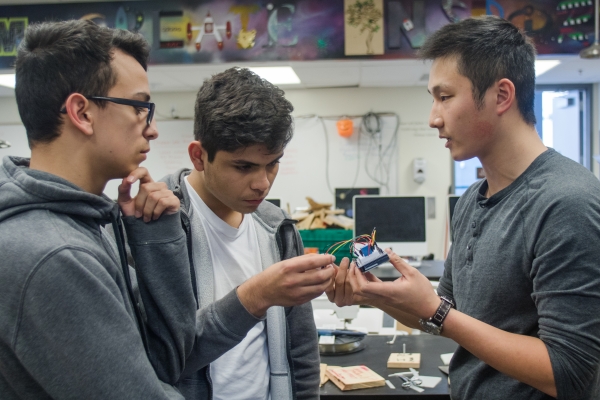Students are uniquely positioned to use invention as a public platform to illuminate the problems they see and the ways those problems are overlooked in their communities.
Connie Liu, Founder and Director, Project Invent
The COVID-19 pandemic, more than any historical moment in the past century, is making clear the numerous correlated problems that threaten the health and well-being of our communities. From supplying personal protective equipment (PPE) to healthcare workers, to changing public health behaviors, to getting meals to those who need them most, to unemployment numbers we haven’t seen since the Great Depression, we have our hands full.
To make matters worse, America’s legacy of pervasive systemic racism, inequitable access to vital resources, and economic and opportunity inequality have been further exacerbated—bringing us to a defining inflection point.
So, where do we go from here? More importantly, who should we call upon to help rebuild and transform our communities for the better?
This is the moment where we must begin to think differently about who is equipped to offer answers, and more specifically, the role we envision young people playing in solving the problems of today and tomorrow.
The Role of Youth in Problem-Solving
Growing up, invention was not part of the learning agenda at my school. It wasn’t until I studied engineering at MIT that I was exposed to the idea that young people could apply their knowledge to solving real-world problems.
I spent my freshman year creating products like FingerReader, a camera mounted on a ring to help blind people read on-the-go. I loved sitting face-to-face with users, empathizing with their challenges, and translating that empathy into impactful inventions. These moments of innovation made me feel empowered in a way I had never experienced in school before. I became passionate about bringing empowering learning opportunities to all students, and, after becoming a high school teacher, founded Project Invent in 2018.
Since my time as a student, the K-12 education system has remained largely the same. However, that can change if we transform our expectations for our youth.
We underestimate the power of youth as problem solvers far too often. However, they continue stepping up in incredible ways to accelerate social change. Young leaders like Greta Thunberg and youth-led collectives like the Sunrise Movement have been at the forefront of climate action activism. And, teenagers like Karina Popovich have been prominent leaders in utilizing 3D printing to deliver life-saving PPE to essential workers during COVID-19.
In every corner of the globe, youth have demonstrated the capacity and determination to harness creative ideas and breathe new energy into social change movements. What’s equally powerful is their ability to use social activism and problem solving as a vehicle for accessing valuable learning opportunities that are (arguably) far more meaningful than the learning that happens within the walls of a conventional classroom setting.
Unleashing students to tackle real-world problems unlocks limitless possibilities for their learning and the impact they can make in their communities (and around the world). Being present to that was the catalyst for founding Project Invent: an incubator for turning loose one of society’s greatest known superpowers—the ingenuity of young people.
Driving Community-Centered Learning Through Invention
Through the intersection of project-based learning, social-emotional learning, service learning, and STEM education, Project Invent empowers students to use their unique gifts and ideas to solve problems they discover in their community. And, if their accomplishments to date are any indication, they’re just beginning to scratch the surface.
Through Project Invent, students are building everything from smart wallets that help the blind detect bill denominations to steering wheel attachments that alert drivers when they become drowsy. This advanced level of invention becomes possible when young people are given the space to examine what’s happening in their world and to then use their creative intuition to improve their community and the lives of others.
In conventional education contexts, students’ learning is driven by textbooks, worksheets, and the pursuit of mastering a standard set of facts. This model is antiquated. What if, instead, our education system focused on building dynamic learning environments with creativity, agency, and empathy at the center? What if students could find themselves in spaces that cultivated a desire for lifelong learning and creative collaboration—enabling them to make meaningful contributions in a rapidly changing world?
Leveraging community assets can serve as a catalyst for creating this future of learning. By giving students the freedom to thrive beyond the four walls of a school and to design service- and impact-related projects for their communities, community-centered learning builds a sense of responsibility in our youth to give back. And, in the process, they discover the interests and passions they want to continue pursuing well into adulthood.
Rising to the Challenges of Tomorrow
Transitioning from textbook to real-world problem-solving is a disruptive change for most schools. With Project Invent, our goal is to make it as easy as possible for any teacher to lead students in innovating for good. We provide teachers support in guiding their students in the process from identifying passion problems to building new technologies. We walk through effective tools for everything from interviewing users, to synthesizing insights, to programming electronics. In practice, the results are truly inspiring.
Take Team Adaptplay—a team of high school students in White Salmon, WA who were inspired to create an invention for a classmate with cerebral palsy. Because individuals with cerebral palsy experience loss of mobility and muscle control, this meant their classmate Jose needed a wheelchair to move from place to place. When the students began their project, they assumed they would be inventing something to support Jose’s mobility. However, it only took one conversation to shift their approach.
The team quickly learned that Jose had little trouble with mobility, and actually dreamed of playing Minecraft like all of his friends. But, he was limited by the available technology. The standard keyboard and mouse were not configured for use by people with different abilities. They immediately pivoted to focus on designing a head-mounted controller for Jose to use to control his computer. Their life-changing invention resulted in an invitation from Microsoft to present their work to the XBOX controller team.

Team Adaptplay meets with Jose to test their design.
Their story is just one example of students tackling problems in their own community through invention. This type of hands-on, imaginative, real-world engagement is an incredible avenue for students to develop agency and greater confidence in their ability to make a difference.
As students develop their ideas, they are able to learn in real time, develop the skills to pivot, and cultivate the resilience to meet the complexities of a real-world problem head on. Even more, students, many of whom have no engineering background, are suddenly able to become entrepreneurs and patented inventors.
With this exposure to innovative problem solving, a world of opportunities opens up to our students. This is the outcome of invention. As one parent put it: “Anytime a program can open up a student to something that they would have never done before, it’s something special.”
What Teachers Can Do
Though young people are driving the innovation, teachers play an important role as well. A key to successful community-centered learning is teachers who create the space for creative risk-taking, peer collaboration, and unbounded curiosity.
Project Invent adopted a key set of foundational practices to enable teachers to provoke (in students) the use of 21st-century mindsets. We empower teachers to follow six practices in their classrooms: make failure okay, push students to the next level, be a co-learner, let students take the wheel, leave room for exploration, and challenge assumptions.
When teachers embody these practices, they invite students to co-create and drive learning that embraces failure and iteration—increasing the possibility for breakthroughs that become launchpads for broad impact.
When grades become the main “reward” for learning and learning becomes tethered to brick and mortar spaces, we forfeit students’ yearning to explore, connect, question, and apply their knowledge to better understand and shape the world around them. Though sometimes messy, this is how powerful learning happens. And, a critical part of that is the support and partnership of adults and communities.
Democratizing Innovation
In this work of invention, our students are addressing the needs of marginalized populations, which are often ignored by innovative efforts in the general marketplace. Robots are used to optimize Amazon deliveries, but we fail to deploy similar technologies to distribute donated goods to those who need it most. There have been tremendous advancements in the design of camping tents, but are we offering those advancements to benefit people in refugee encampments?
By catalyzing the current generation of entrepreneurs and inventors to think about these disparities and their role in democratizing innovation, we have the opportunity to normalize the use of our greatest technologies for social good.
Students are uniquely positioned to use invention as a public platform to illuminate the problems they see and the ways those problems are overlooked in their communities. We believe that young people have an innate desire to do meaningful work, and nothing can be more powerful for their self-confidence and agency than to see themselves make a unique impact on the world. And, by seeing all students as innovators, we honor their capacity to be changemakers and build a more equitable and inclusive future through harnessing imagination and innovation.
With a world in crisis, it is more important than ever for communities to come together and involve all generations in creating solutions.

